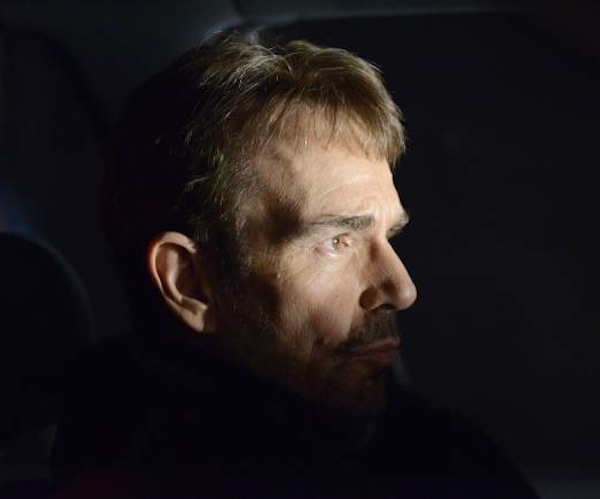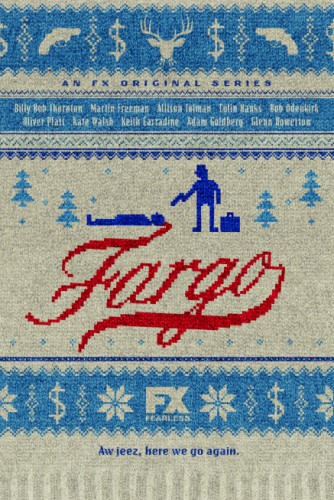TV Review: “Fargo”: or, Do Contract Killers Get Bored and Create Chaos for Fun?
“Fargo” creates its own world of crime and moral conundrums while delivering a fair share of blood. Whether the TV series delivers on its promise to be in the same aesthetic world as the original movie is an open question.
By Rob Ribera
SPOILERS AHEAD: It is difficult to judge the new FX series Fargo (which premieres tonight) without comparing it to the source material, the 1996 neo-noir film of the same title that won the Coen brothers a screenwriting Oscar and cemented their reputation as masters of modern cinema in terms of form, style, and, if you’d like to go there, philosophy. In the case of Fargo the film, the Coen’s toyed with nihilism while exploring the moral struggles of a man who just wants to get ahead, but ends up blundering into a series of crimes that wind up destroying his life. It is a beautiful and terrifying film, a dark comedy that shows how a mundane life can be transformed in an instant by a disastrous choice. It is fair to say at the outset, however, that the small screen version, try as it might, does not quite match its predecessor. There are some bright spots along the way, and by the time the series reaches its fourth episode – the last of what was provided to reviewers – it begins to hit a bit of a stride. Still, this ten-part limited series is built on shaky foundations. I remain cautiously intrigued.
The plot, though inspired by the “true” events and overall mood of the film, is set a decade later, in the nearby town of Bemidji. Martin Freeman plays Lester Nygaard, an insurance salesman who lives in the shadow of his more successful younger brother. He is belittled by all, including his wife, who faults him for not being able to fix their washing machine or make enough money to afford a new stereo system. One day, an old high school bully bumps into Lester on the street and, flanked by his two dim-witted sons, slips into his old ways and picks on poor Lester once more. Before you know it, the unlucky Nygaard is in the hospital with a busted nose and a bruised sense of self.
Enter Lorne Malvo, played by Billy Bob Thornton, who sits with Lester in the waiting room. Malvo is a seasoned hit man who in later episodes is shown to have illicit pharmaceutical connections. For some reason, Malvo has decided to visit the emergency room in the town where he just flipped a car and bungled another kidnapping job. This improbable meet-cute sets murderous wheels in motion. Malvo criticizes Nygaard’s sorry state of affairs, and suggests that he would have killed the bully. Nygaard suggests that Malvo do it for him. Malvo takes this wish seriously. Apparently, contract killers get so bored they will do pickup work for strangers. And so Malvo puts a knife in the bully’s neck. His confidence buoyed by a pep talk from his new hit-man life coach, Lester takes a hammer to his wife’s skull following one put down too many. Drama and hilarity ensue. None of the above should be considered a spoiler because the basic plot isn’t the point here; what is interesting is watching the chess pieces move (and fall) once the game is set in motion.
While the show is not a sequel or a reimagining, series creator Noah Hawley, who wrote all ten episodes, throws in a fair amount of Coen-related twists and nods. Billy Bob Thornton’s Malvo, a watered-down version of Anton Chigurh from No Country for Old Men, claims that he is a “student of institutions,” at one point informing Lester that “there are no rules.” He isn’t all that scary, really, though he gives convincing little speeches to the weaker folk that nudge them further into chaos. Instead of the kidnappers in the film version (one who won’t shut up and the other who stays scarily silent), we get a different pair of criminals, one of whom must use sign language because he is mute. There are plenty of other Coen connections: a painting of a pair of scissors from The Big Lebowski is here morphed into a picture of an ice scraper; there is a sign for a special on White Russians, The Dude’s drink of choice, and a dopey personal trainer thinks he knows it all, which resonates with a similar figure in Burn After Reading.
There are many more allusions to the Coen universe, all of which are interesting and fun to spot, though in the end I can’t help but wonder if the show would fare better if it was placed further outside of the confines of the film. Perhaps then it could breathe and take on a life of its own. Instead, series creator Hawley has acknowledged the inspiration of the Coen’s and films like Fargo. So the series is tethered (maybe chained?) to the source material — to the point where you can’t help but make comparisons between William H. Macy’s Jerry Lundegaard and Martin Freeman’s Lester Nygaard, a battle that unquestionably goes to Macy.
That said, the show picks up speed after the first few episodes. While it may not match the original — and perhaps that was not Hawley’s intention — it has its moments. Allison Tolman, who plays Molly Solverson (get it?), who is on the verge of piecing the mystery together, is a revelation here. Though she is surrounded by a group of big name stars, the relatively unknown actress manages to stand out, supplying her policewoman role with the same sincerity and warmth as Frances McDormand did as Marge Gunderson in the film version. In fact, Tolman’s character seems even more willing to delve into into the heart of darkness. Colin Hanks reminds us that there is another talented actor in the family who should be working more. The cinematography and use of the landscape is evocative, creating a nuanced mood of despair, with characters moving like little ants across the wide expanse of the Minnesota tundra. Much of the acting is solid, and the dialogue mostly witty and funny. While flawed, Fargo creates its own world of crime and moral conundrums while delivering a fair share of blood. Whether the TV series delivers on its promise to be in the same aesthetic world as the original movie is an open question.
Rob Ribera is a filmmaker and music video director in Boston. He is the co-creator of the music website Sleepovershows.com, and is currently working on his PhD.in American Studies at Boston University.


